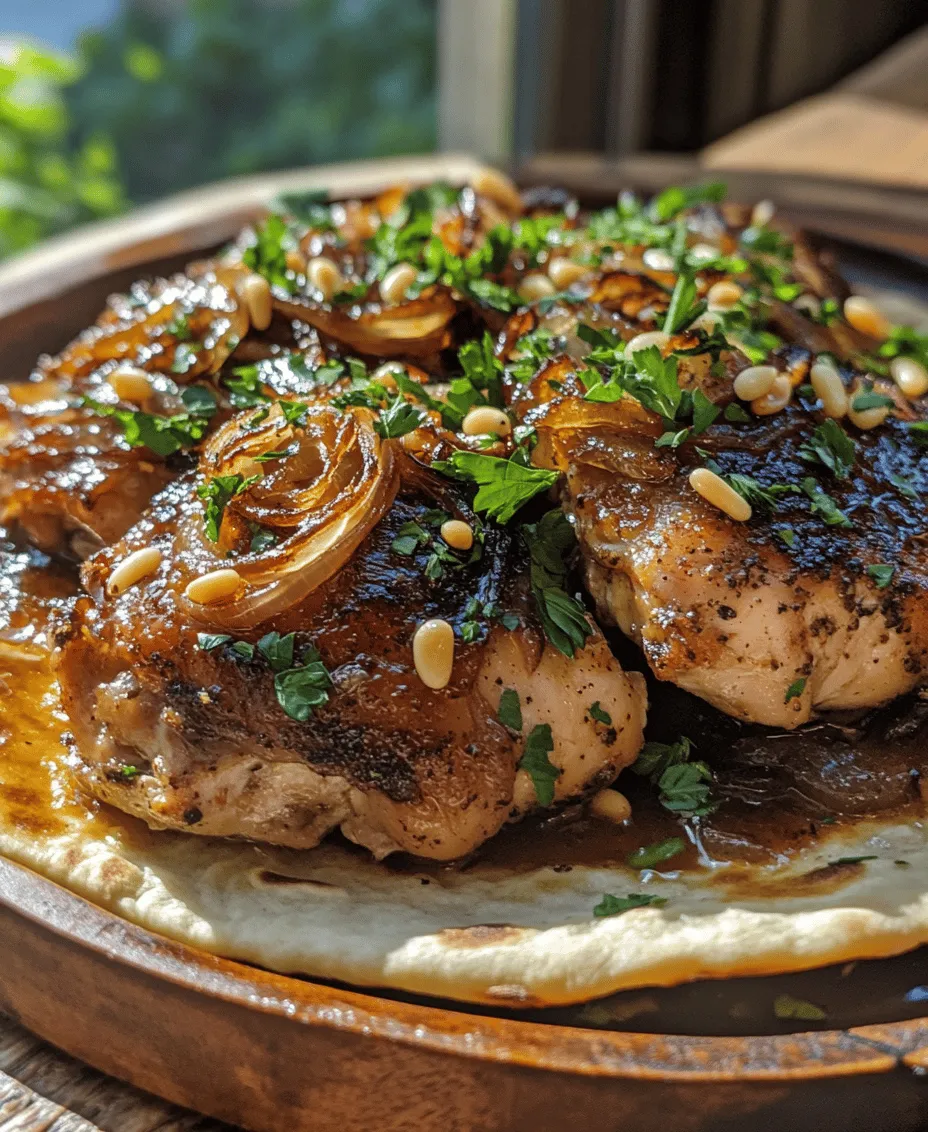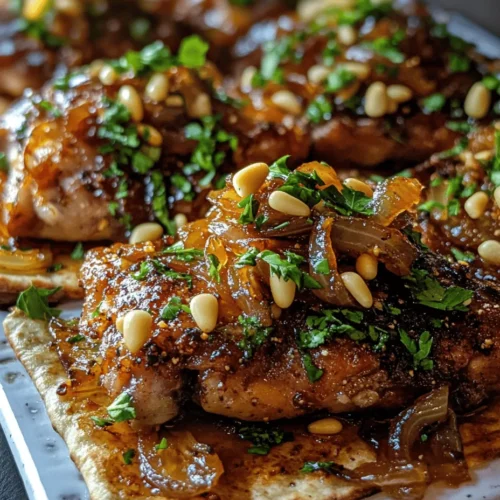Introduction
Musakhan is a cherished traditional dish from the Middle East, often celebrated for its depth of flavor and comforting qualities. This iconic Palestinian recipe showcases the vibrant tastes of sumac, a spice that adds a unique tanginess to the dish, making it a beloved favorite among many. With its tender chicken, fragrant onions, and aromatic spices, Musakhan is more than just a meal; it is a cultural experience that brings families together.
In this article, we will explore the enchanting world of Musakhan, uncovering its rich history and the essential ingredients that make it a standout in Middle Eastern cuisine. We will also guide you through the preparation steps to create your own Musakhan at home, ensuring that you can experience the magic of this dish in your kitchen.
Understanding Musakhan
Musakhan’s origins can be traced back to Palestinian cuisine, where it is regarded as the national dish. It is a dish that embodies the essence of home-cooked meals, often prepared during special occasions, gatherings, and family celebrations. Historically, Musakhan was a way to utilize the bounty of the harvest, particularly with the use of sumac, a spice derived from the dried and ground berries of the sumac plant, which thrives in the Middle East.
The traditional components of Musakhan include chicken, sumac, onions, and olive oil, all served atop flatbread. Variations of the dish can be found across the Levant region, with each area adding its unique twist. Some may incorporate additional spices, while others might serve it with different types of bread or sides. Regardless of the variations, the heart of Musakhan remains the same: a celebration of simple yet flavorful ingredients that come together to create a memorable dish.
In Middle Eastern culture, communal dining holds significant importance, especially when sharing a dish like Musakhan. It is often served in large platters, encouraging everyone to gather around the table, share stories, and enjoy the meal together. This sense of community and connection is integral to the experience of enjoying Musakhan, making it not just a dish but a celebration of togetherness.
Ingredients Breakdown
To create a delightful Musakhan, it is essential to understand the role of each ingredient in the recipe. Here’s a breakdown of the key components:
Chicken Thighs
For Musakhan, using bone-in, skin-on chicken thighs is highly recommended. This cut of meat not only enhances the flavor but also helps retain moisture during cooking, resulting in tender, juicy chicken. The bones contribute to a richer taste, and the skin crisps up beautifully, adding texture to the dish. When cooked with sumac and onions, the chicken absorbs the flavors, making each bite a delicious experience.
Sumac Spice
Sumac is the star of the show in Musakhan, known for its vibrant red color and tangy flavor profile. This spice is not only a culinary staple in Middle Eastern kitchens but also offers various nutritional benefits. Sumac is rich in antioxidants and has been linked to several health benefits, including anti-inflammatory properties. Beyond Musakhan, sumac can be used in salads, marinades, and even sprinkled on roast vegetables, making it a versatile addition to your spice collection.
Onions
Onions play a crucial role in Musakhan, providing sweetness and depth of flavor. The process of caramelizing the onions is vital, as it enhances their natural sugars and adds a rich, golden color to the dish. When cooked slowly, caramelized onions become soft and sweet, contrasting beautifully with the tanginess of the sumac and the savory chicken. The combination of these flavors creates a harmonious balance that is characteristic of Musakhan.
Olive Oil
Olive oil is a quintessential ingredient in Mediterranean cuisine, celebrated for its health benefits and flavor. In Musakhan, olive oil is used not only for cooking but also to drizzle over the dish before serving, adding richness and a fruity aroma. Extra virgin olive oil, in particular, is packed with healthy fats, antioxidants, and anti-inflammatory properties, making it a heart-healthy choice. Its significance in this recipe highlights the Mediterranean diet’s emphasis on wholesome, natural ingredients.
Optional Ingredients
While the core components of Musakhan are essential, optional ingredients like pine nuts and fresh parsley can elevate the dish further. Pine nuts, when toasted, add a delightful crunch and nutty flavor, complementing the tender chicken and onions. Fresh parsley, sprinkled as a garnish, contributes a pop of color and freshness, enhancing the overall presentation. These ingredients are not necessary but can provide additional layers of flavor and texture, making your Musakhan even more special.
Preparation Steps
Now that we have explored the ingredients, let’s dive into the preparation steps to create your own Musakhan. The process is simple yet requires attention to detail to ensure that each component shines.
1. Marinate the Chicken: Start by preparing the marinade for the chicken. In a large bowl, combine a generous amount of sumac with olive oil, salt, and pepper. Coat the chicken thighs in this mixture, ensuring they are well covered. Allow the chicken to marinate for at least 30 minutes, or up to overnight in the refrigerator if time permits. This step is crucial, as it allows the flavors to penetrate the meat.
2. Caramelize the Onions: In a large skillet or pan, heat olive oil over medium heat. Add thinly sliced onions and a pinch of salt. Cook the onions slowly, stirring occasionally, until they become soft and golden brown. This process can take about 15-20 minutes, but the result is well worth the wait. The caramelization will enhance the sweetness of the onions and provide a rich base for the dish.
3. Cook the Chicken: Once the onions are caramelized, push them to the side of the pan and add the marinated chicken thighs. Sear the chicken on both sides until golden brown, which should take about 5 minutes per side. This step locks in flavor and ensures a crispy skin.
4. Combine Ingredients: After the chicken is browned, mix the onions back into the pan with the chicken. Add a splash of water or broth to the pan to create a bit of steam, which will help cook the chicken through while keeping it moist. Reduce the heat to low, cover the pan, and let it simmer for about 30 minutes until the chicken is fully cooked and tender.
5. Prepare the Flatbread: While the chicken is simmering, prepare your choice of flatbread. Traditional Musakhan is served on taboon bread, a Middle Eastern flatbread, but any flatbread or pita will work. Warm the bread in the oven or on a skillet until soft and pliable.
By following these steps, you are well on your way to creating a delicious Musakhan that captures the essence of Middle Eastern flavors and traditions. Embrace the process, and let the enticing aromas fill your kitchen as you prepare this beloved dish.

Marinating the Chicken
Marination is a crucial step in creating a flavorful Musakhan, as it allows the spices and seasonings to penetrate the chicken, enhancing its taste and tenderness. For the best results, it is recommended to marinate the chicken for at least 2 hours, but ideally, you should allow it to sit overnight in the refrigerator. This extended marination time enables the sumac, olive oil, and other spices to fully infuse into the meat, resulting in a rich flavor profile that is characteristic of this traditional dish.
To marinate the chicken, mix together olive oil, sumac, salt, black pepper, and any other spices you choose to incorporate, such as paprika or cumin. Coat the chicken pieces thoroughly, ensuring that every surface is covered with the marinade. Place the marinated chicken in a sealed container or a resealable plastic bag, and store it in the refrigerator. If you’re short on time, even a quick 30-minute marination can add a layer of flavor, but remember that longer is better for optimal results.
Preparing the Onions
The onions in Musakhan are not just a side note; they play a pivotal role in developing the dish’s overall flavor. Properly caramelized onions add a sweetness that balances the tanginess of the sumac and the richness of the chicken. To achieve that perfect caramelization, start by slicing the onions thinly and cooking them slowly over medium-low heat.
Heat a generous amount of olive oil in a large skillet, then add the sliced onions and a pinch of salt. The salt helps to draw out moisture, allowing the onions to soften and brown evenly. Stir frequently, allowing the onions to cook for about 20 to 30 minutes until they are golden brown and tender. This slow cooking process is key; rushing it will lead to uneven cooking and a lack of the deep, sweet flavor that makes caramelized onions so desirable.
As the onions caramelize, the aroma will fill your kitchen, creating an enticing atmosphere that hints at the delicious meal to come. Once they are ready, remove them from the heat and set aside while you prepare the chicken.
Cooking the Chicken
With the chicken marinated and the onions caramelized, it’s time to bring everything together. Start by heating a large skillet or pot over medium-high heat. Add a splash of olive oil and allow it to get hot. Carefully place the marinated chicken pieces into the skillet, ensuring not to overcrowd the pan. Searing the chicken properly is essential, as it creates a delicious crust that locks in the juices.
Cook the chicken for about 5-7 minutes on each side, or until it develops a golden-brown crust. It’s important to monitor the heat; if it’s too high, the outside will burn while the inside remains undercooked. Once the chicken is nicely browned, lower the heat to medium and add the caramelized onions back into the skillet. Pour in a bit of chicken broth or water to create a simmering environment, which will help keep the chicken moist and allow the flavors to meld beautifully.
Cover the skillet and let the chicken simmer for about 20-30 minutes, depending on the size of the pieces. Use a meat thermometer to ensure the chicken reaches an internal temperature of 165°F (75°C). This will guarantee that the chicken is fully cooked while remaining juicy and tender.
Toasting the Flatbread
The final touch to your Musakhan is the flatbread, which serves as the base for this delightful dish. You have a few options for toasting the flatbread, each yielding a slightly different texture. One method is to place the flatbread directly on a hot skillet or griddle for about 2-3 minutes on each side until it’s warm and slightly crispy. Alternatively, you can pop it in the oven at 375°F (190°C) for about 5-7 minutes.
Whichever method you choose, aim for a warm, crispy texture that can hold the weight of the chicken and onions without becoming soggy. Once toasted, spread a layer of the caramelized onion mixture on the flatbread, followed by the succulent pieces of chicken. This layering not only looks appealing but also enhances the overall flavor experience as each bite combines the chicken’s juiciness with the sweet, rich onions and the earthy flatbread.
Serving Suggestions
To present your Musakhan beautifully, place the layered flatbread with chicken and onions on a large platter. Garnish it with fresh parsley or cilantro for a pop of color and flavor. Traditional accompaniments such as lemon wedges are essential, as they provide a refreshing contrast to the rich, spiced chicken. The acidity of the lemon brightens the dish and balances the flavors wonderfully.
For additional side dishes, consider serving a simple cucumber and tomato salad dressed with olive oil and lemon juice. This will add a refreshing crunch that complements the softness of the Musakhan. Alternatively, a side of yogurt with a sprinkle of mint can enhance the dish and provide a cooling effect, making each bite more enjoyable.
Nutritional Information
When it comes to nutritional information, Musakhan is a wholesome meal that provides a balanced array of nutrients. A typical serving of Musakhan (approximately 1 cup of chicken and onion mixture served on flatbread) contains:
– Calories: 450
– Protein: 30g
– Fats: 20g
– Carbohydrates: 35g
The primary ingredients offer various health benefits. Chicken is an excellent source of lean protein, essential for muscle repair and growth. Sumac, a key spice in this dish, is rich in antioxidants and has anti-inflammatory properties. Olive oil provides healthy fats, which can support heart health, while onions are low in calories and rich in vitamins and minerals, including vitamin C and B6.
Cultural Significance of Musakhan
Musakhan holds a special place in Palestinian culture and is often associated with celebrations and family gatherings. Traditionally enjoyed during the olive harvest season, this dish is a symbol of hospitality and communal dining. It is frequently prepared for large family meals, making it a dish that brings people together.
In Palestinian heritage, Musakhan is more than just food; it is a story of resilience and connection to the land. It embodies the flavors of the region and reflects the agricultural practices that have been passed down through generations. As one Palestinian chef remarked, “Musakhan is not just a dish; it is a celebration of our culture, our history, and our love for good food.”
Conclusion
Musakhan is a delightful blend of flavors and textures that showcases the beauty of Palestinian cuisine. The combination of sumac-spiced chicken, sweet caramelized onions, and warm flatbread creates an unforgettable dining experience. Whether you are a seasoned cook looking to explore authentic Middle Eastern flavors or a newcomer eager to try something new, this recipe offers a taste of tradition that is sure to impress.
As you prepare Musakhan, remember that it is not just about the food but the experience of sharing it with loved ones. This dish invites you to gather around the table, enjoy hearty flavors, and celebrate the joy of communal eating. So roll up your sleeves and dive into this culinary adventure; you won’t be disappointed.



